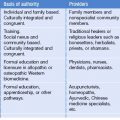CHAPTER 14 Differential Diagnoses of Ill Immigrants by Organ System
Introduction
Every year thousands of individuals leave their countries of birth to settle in the United States (US). In fact, nearly 12% of the people residing in the US are foreign born.1 Although certain regions have a higher percentage of this population, all 50 states are home to immigrants from a wide range of geographical regions. Therefore, American healthcare providers will likely be involved in the care of an immigrant patient at some point in time, regardless of their practice location or medical specialty. Unfortunately, US-trained clinicians are often unaccustomed to diagnosing and treating many of the illnesses that disproportionately burden immigrants, such as tuberculosis (TB), malaria, intestinal parasites, and rheumatic heart disease. This chapter, organized by organ system, is intended to provide healthcare providers with an overview of many of the diseases commonly encountered in immigrant patients. By taking into account the predominantly affected organ system, presenting symptoms, patient’s homeland, timing of immigration, and exposure history, an appropriate differential diagnosis may be generated. Determining this differential diagnosis facilitates timely diagnostic testing and aids in the development of appropriate management strategies.
Nervous System
In an immigrant population, a number of both infectious and non-infectious diseases, can present with neurological symptoms (Box 14.1). Several of the most commonly encountered symptoms include headache, focal deficits, weakness, sensory changes, seizures, and psychological complaints.
Box 14.1 Differential diagnosis of common neurological disorders
Headache
Headache
A progressively worsening headache may be due to increased intracranial pressure caused by space-occupying lesions such as neoplasm or localized infection. Cysticercosis, the most common parasitic brain infection worldwide, is endemic in Mexico, Central and South America, sub-Saharan Africa, and Asia.2 It often presents with chronic headache or afebrile seizures. Intracranial tuberculomas due to infection with Mycobacterium tuberculosis can also cause headache without evidence of extracranial disease. Other infections associated with space-occupying lesions include toxoplasmosis, trichi-nosis, echinococcosis, schistosomiasis, amoebiasis, and paragonimiasis.
Headache associated with fever, confusion, or nuchal rigidity may indicate meningitis or encephalitis. Bacterial meningitis due to Neisseria meningitis is of particular concern in individuals who have lived in or traveled through the ‘meningitis belt’ of sub-Saharan Africa.3 Those who have taken part in the annual Muslim Hajj pilgrimage are also at increased risk.4 Infection caused by Streptococcus pneumoniae and Haemophilus influenza type b may occur at a higher rate in newly relocated immigrant children due to lack of routine immunization in most developing areas. Other bacterial pathogens that cause meningitis and encephalitis include L. monocytogenes, Treponema pallidum, and M. tuberculosis. Viral etiologies include members of the flaviviridae family (dengue fever, Japanese encephalitis, West Nile virus), arboviruses, enteroviruses, human immunodeficiency virus (HIV), herpes simplex virus (HSV), measles, and mumps. Tick-borne illnesses such as Lyme disease and babesiosis, as well as other insect-borne infections such as malaria and trypanosomiasis must also be considered in the differential diagnosis of immigrants with headache and fever.
Focal motor deficits
Although many of the diseases mentioned above can present with focal neurological signs, cerebrovascular accident (CVA) must always be considered in any patient presenting with new focal findings. Worldwide, cerebrovascular disease accounts for over four million deaths yearly; nearly 70% of these deaths occur in less affluent countries.5 While the common risk factors for cerebrovascular disease, such as hypertension, diabetes, hyperlipidemia, and smoking, are important in immigrant populations, other unique causes of stroke must be considered in this population as well. In young patients presenting with stroke, rheumatic heart disease, Chagas’ disease, sickle cell disease, and tertiary syphilis are possible underlying etiologies. Moya Moya disease, a vascular condition most common in Asians, can present with stroke. Asians, particularly young women, may present with stroke related to Takayasu’s arteritis.
Weakness
Weakness may be the result of brain, spinal cord, peripheral nerve, or muscle pathology. Cerebral vascular accident and space-occupying lesions are important central causes. Spinal cord disease can be secondary to TB, metastatic malignancies, HIV, schistosomiasis, gnathostomiasis, or syphilis. Human T-lymphotropic virus (HTLV), a retrovirus endemic to most of the tropical developing world, has been shown to play a causative role in HTLV-associated myelopathy/tropical spastic paresis (HTLV/TSP).6 This condition presents with slow-onset spastic paresis associated with bladder dysfunction and variable degrees of sensory deficits and must be differentiated from Guillain-Barré syndrome. Both polio and rabies can present with paralysis. Given that the incubation period of rabies can be months, immigrants may present with new infection after being in the US for an extended period of time; it is therefore very important to ask about any history of animal contact, even remote, in patients presenting with weakness.7
Sensory deficits
Sensory changes may be associated with several of the infectious agents that cause weakness including polio, HTLV-1 (tropical spastic paresis), HIV, and rabies. A progressive symmetrical peripheral neuropathy in individuals from the tropics may be due to lepromatous leprosy. Noninfectious causes of sensory changes are also common. Guillain-Barré syndrome, a disease thought to be autoimmune in etiology, can present with sensory deficits and weakness. Immigrants may present with a slowly progressive sensorimotor neuropathy associated with ataxia; this condition, known as tropical ataxic neuropathy, is associated with heavy consumption of cassava, a root commonly consumed in regions of Africa, Asia, and Latin America.8 With the increasing worldwide incidence of diabetes mellitus, diabetic peripheral neuropathy is commonly seen as well.
Nutrient deficiency is another important cause of sensory dysfunction. Thiamine deficiency (beriberi), a particular problem in refugee populations that subsist on rice-based foods, is associated with ataxia and peripheral neuropathy.9 Deficiencies of vitamins B6, B12, and niacin (pellagra) can also cause peripheral neuropathy.
Various neurologic abnormalities
Varied neurologic signs and symptoms, including cognitive deficits, may be due to exposure to toxins such as lead, mercury, and arsenic. Lead poisoning is particularly prevalent in refugee children.10 Even after resettlement in the US, continued exposure may occur through imported ceramics, traditional medications, cosmetics, and paint in older homes. Many immigrants are not aware of the dangers of lead exposure.11 Malnutrition and iron deficiency, both prevalent in the refugee populations, increase the likelihood of lead toxicity.11 Chronic lead exposure is associated with hyperactivity, developmental delay, irritability, behavioral problems, peripheral neuropathy, and hearing loss. These symptoms can easily be confused with attention deficit disorder.
As with lead toxicity, exposure to methyl mercury results in numerous neurological symptoms. Toxicity generally presents with irritability, paresthesias of the limbs and perioral area, ataxia, muscle weakness, dysarthria, paralysis, difficulty with swallowing, and seizures. The degree to which mercury poisoning causes neurologic abnormalities in resettled populations is unknown. However, historically, there have been several large outbreaks of methyl mercury toxicity. In Iraq, thousands of people were affected after consuming bread made from mercury-contaminated grain.12 Release of methyl mercury into the Minamata Bay in Japan led to hundreds of cases of toxicity via consumption of contaminated fish.12 In other parts of the world, such as the Amazon, high mercury levels are thought to be due to gold mining and agricultural practices.13 Arsenic toxicity, most common in immigrants from Bangladesh and India, can cause peripheral neuropathy and skin changes.14 It should also be kept in mind that traditional medications may contain neurotoxic materials such as strychnine and arsenic, so it is always important to ask patients specifically about the use of traditional remedies.15
Psychological complaints
Although organic disorders can produce mood and sleep disturbances, anxiety, irritability, sexual dysfunction, hallucinations, panic attacks, and cognitive deficits, these symptoms may be seen in an immigrant suffering from a mental illness. An estimated two-thirds of refugees experience some form of anxiety or depression.16 Exposure to violence, trauma, and upheaval prior to immigration as well as poverty, unemployment, social isolation, and language difficulties following immigration likely contribute to the increased rate of psychiatric complaints.16,17 The most common psychiatric disorder amongst this population is post-traumatic stress disorder (PTSD); refugees are nearly 10 times more likely to develop PTSD than age-matched native-born controls.16,18 Compared to native-born populations, somatoform disorders occur with increased frequency in resettled populations.19,20 These disorders are particularly challenging for clinicians, as it is often very difficult to determine if symptoms have an organic basis. It is vitally important for healthcare providers to address these mental health conditions, especially given the risk of suicide with untreated disease.18 Screening for alcohol and substance abuse is also important; although immigrants do not appear to be at greater risk for abuse than US-born individuals, abuse is still very prevalent and has significant health and social consequences.21
Eye
According to the World Health Organization (WHO), there are 37 million people worldwide with bilateral blindness (3/60 visual acuity or less); an additional 161 million individuals have severe impairment in both eyes (visual acuity less than 6/18 but better than 3/60).22 It has been estimated that 90% of cases of blindness occur in developing regions.23 Congenital defects, defects secondary to aging, infections, and nutritional deficiency can all affect the eye adversely (Box 14.2). Given the scope of this problem and the high likelihood of caring for an immigrant with ophthalmologic complaints, it is important for clinicians to have a basic understanding of several of the most common ophthalmologic conditions encountered in this population.
Box 14.2 Differential diagnosis of ophthalmologic conditions
The most common cause of blindness worldwide is cataracts, both congenital and age-related.22,23 The high prevalence of cataracts in developing regions is largely due to poor access to surgical correction.24 Diabetic retinopathy is another common cause of visual impairment. In immigrants, disease may be quite advanced at time of presentation due to lack of routine screening and poor diabetic control prior to immigration.
Trachoma, caused by Chlamydia trachomatis, is yet another important cause of visual impairment; an estimated 84 million people worldwide are currently infected.25 Trachoma causes progressive visual loss through scarring and revascularization of the cornea. Since treatment with antibiotics and surgery (in more advanced cases) can halt the progression to blindness, it is very important to recognize this condition.25
A number of other infections cause ophthalmologic symptoms. Amongst protozoan infections, filariasis (Loa loa in tropical Africa and Onchocerca volvulus in Africa, South America, and the Middle East) and toxocariasis can cause an array of complications including conjunctivitis, photophobia, keratitis, uveitis, optic atrophy, and blindness. Congenital toxoplasmosis frequently leads to visual impairment; interestingly, loss of visual acuity and new eye lesions may occur as late as the third or fourth decades of life.26 Systemic diseases such as leptospirosis, dengue fever, and measles are often associated with characteristic ophthalmologic symptoms. For example, conjunctival suffusion is a classic sign of leptospirosis, and retro-orbital pain is typical of dengue fever. Chagas’ disease may mimic periorbital cellulitis (Romaña’s sign). Although less common than in past generations, leprosy still exists and can also cause visual damage.
Ophthalmologic problems in immigrant children may be due to vitamin A deficiency. This condition, known as xerophthalmia, is the most common cause of childhood blindness worldwide, affecting over 1.5 million children.24 The symptoms and signs associated with xerophthalmia include night blindness, Bitot’s spots (irregular gray or white conjunctival patches), corneal xerosis, ulceration, scarring, and eventual blindness.9 Treatment can reverse many of these complications, so timely and proper diagnosis is imperative.
Immigrants, particularly those from regions of unrest, may present with trauma-related eye complaints. These traumatic injuries are often due to land mines.24 Corneal ulcerations may also result from use of traditional ophthalmologic medications; questions regarding the use of these medications should be included in the evaluation of immigrant patients presenting with ophthalmologic complaints.
Cardiovascular System
Cardiovascular diseases most commonly seen in immigrant populations can be separated into the broad categories of congenital anomalies, valvular disorders, vascular abnormalities, pericardial disease, myocarditis, and cardiomyopathies (Box 14.3). Despite the differences in underlying pathology, it is important to remember that many of these conditions will present similarly.
Box 14.3 Differential diagnosis of cardiovascular conditions
Pericarditis/myocarditis
Infectious causes
Viral (echoviruses, adenoviruses, coxsackieviruses, HSV, HIV)
Bacterial (Staphylococcus, Pneumococcus, tuberculosis, brucellosis, rickettsial organisms)
Protozoal (Chagas’ disease, toxoplasmosis, malaria, leishmaniasis)
Helminthic (trichinosis, echinococcosis, schistosomiasis, filariasis)
Congenital heart anomalies may be diagnosed because of an asymptomatic murmur; however, they may also present with heart failure, cyanosis, dyspnea, polycythemia, or digital clubbing. Although congenital heart diseases occur with similar frequencies in developed and developing regions, far more children in developing nations remain undiagnosed and untreated.27 It is therefore important for clinicians to perform thorough cardiac examinations on all immigrant patients, not only children, keeping in mind the possibility of congenital abnormalities. The most commonly encountered congenital heart diseases include ventricular and atrial septal defects, patent ductus arteriosis, and pulmonary stenosis. However, a clinician may also discover unexpected conditions such as tetralogy of Fallot or aortic coarctation, even in adolescent patients.
An estimated twelve million individuals worldwide have rheumatic heart disease; the prevalence is particularly high in Africa and the Pacific Islands.28 As with congenital heart disease, rheumatic valve disease may present as an asymptomatic murmur but may also cause heart failure or stroke. Valvular disease in an immigrant may also be caused by infective endocarditis; it is particularly important to consider this if systemic symptoms are present, although long-term valvular defects can result from previous episodes of endocarditis. Aortitis secondary to syphilis can cause aortic valve dysfunction as well.
Chest pain in an immigrant may be due to coronary artery disease. As the prevalence of cardiac risk factors such as diabetes mellitus, hypertension, obesity, and smoking are increasing in developing regions, coronary artery disease is becoming increasingly common in individuals from these areas. In fact, according to the WHO, 60% of the global burden of coronary artery disease is in the developing world.29 Furthermore, once immigrants move to the US and adopt often unhealthy Western habits, their risk likely increases further. Acute chest crisis secondary to sickle cell disease should also be considered when an immigrant (particularly if the patient is of African heritage) presents with chest pain.
Like pericarditis, myocarditis also has many diverse causes. Infectious etiologies include viruses such as coxsackieviruses, herpes simplex virus, Epstein-Barr virus (EBV), and HIV; rickettsial diseases such as scrub typhus; bacterial infections including brucellosis, TB, and leptospirosis; protozoal infections such as toxoplasmosis, malaria, and leishmaniasis; and helminth infections such as trichinosis, echinococcosis, schistosomiasis, and filariasis.30–32 In immigrants from Central and South America, Chagas’ disease, caused by the protozoa Trypanasoma cruzi, is a common cause of myocarditis and cardiomyopathy.33
Respiratory Tract
Respiratory complaints such as dyspnea or cough in immigrants may be due to infections, chronic noninfectious lung diseases, vascular pathology, or malignancy (Box 14.4).
Box 14.4 Differential diagnosis of respiratory tract conditions
Acute symptoms
Infectious causes
Bacterial (Staphylococcus, Pneumococcus, Chlamydia pneumoniae, Mycoplasma pneumoniae, melioidosis)
Viral (influenza, adenovirus, parainfluenza, respiratory syncytial virus, measles, SARS)
Protozoal (malaria, amoebiasis)
Migratory phase of helminth infections (Ascaris, Strongyloides, hookworm)
Acute lower respiratory tract infections are the leading cause of infection-related mortality worldwide.34 Overcrowding and inadequate sanitation often found in refugee camps facilitate person-to-person spread of respiratory pathogens. Many of the viruses and bacteria that cause acute lung infections in refugees and recent immigrants are the same pathogens responsible for disease in the US (such as pneumococcus and influenza). Given that one-third of the world’s population is infected with TB and that nearly 55% of cases in the US are in foreign-born individuals, it is extremely important to consider this infection in any patient with pulmonary complaints.35 All immigrants and refugees must be screened for TB, and the diagnosis should be strongly suspected in any individual with chronic cough, chest pain, hemoptysis, or weight loss. However, it should be remembered that over 40% of TB cases in immigrants are extrapulmonary at time of diagnosis, so classic pulmonary symptoms may not be seen.36–39 Pulmonary anthrax is of great public concern with its high mortality rate, but it is quite rare and generally limited to endemic areas.
Given the high rate of parasitic disease in immigrants, these infections must be considered in patients presenting with respiratory complaints. The migratory phase of parasitic infections such as Ascaris lumbricoides, Strongyloides stercoralis, toxocariasis, and hookworm can cause coughing and wheezing. It is particularly important to evaluate patients from endemic regions for Strongyloides infection prior to any steroid or immunosuppressive treatment, as hyperinfection syndrome may be precipitated by these treatments. This syndrome is associated with respiratory failure and/or Gram-negative sepsis and carries a 30–70% mortality rate.40 Other parasitic infections that can cause pulmonary symptoms include malaria, amoebiasis, filariasis, and paragonimiasis. Pulmonary hypertension, which can be caused by schistosomiasis, can also present with dyspnea.41 In immigrants from Southeast and Northern Asia with pulmonary symptoms, melioidosis (caused by infection with the bacteria Burkholderia pseudomallei) should be considered. This infection can be dormant for years; in fact, there have been cases of active disease developing up to 29 years after exposure.42
Pulmonary complaints, both acute and chronic, may also be due to noninfectious etiologies. Acute chest syndrome in a patient with sickle cell anemia can present with severe chest pain, dyspnea, cough, and infiltrates on chest radiograph. Chronic pulmonary complaints may be due to asthma or chronic obstructive pulmonary disease. Although often regarded as diseases of the developed world, environmental exposures and cigarette use have contributed to increasing rates of chronic lung conditions in developing regions. In Costa Rica for example, an estimated 13% of the population suffers from asthma.43
Lung cancer should be considered in immigrants with chronic pulmonary complaints and no evidence for infectious cause. Over two million men in developing nations are estimated to die each year from smoking-related diseases, the most common of these being lung cancer.5 Pollution and occupational exposures may also increase immigrants’ risks of developing malignancy.
Stay updated, free articles. Join our Telegram channel

Full access? Get Clinical Tree







